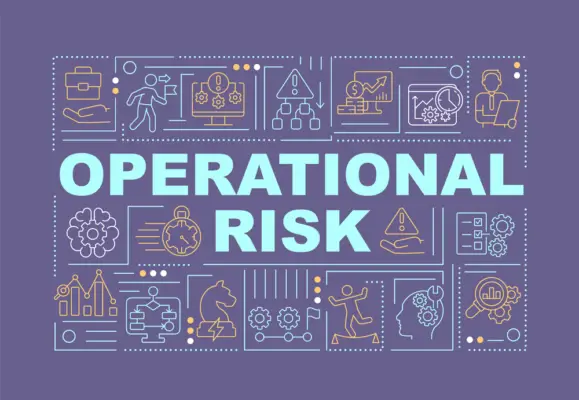Risk Control Self-Assessments (RCSA) are critical in operational risk management. RCSAs allow organizations to identify potential operational risks by having process owners evaluate risks and controls. Some key reasons why RCSA is crucial include:
- It promotes risk identification and mitigation from a bottom-up perspective. As the LinkedIn article explains, RCSA fosters the evaluation of operational risks by those directly involved in day-to-day operations. This allows for comprehensive risk identification.
- RCSA facilitates risk/control monitoring and reporting. By involving process owners, RCSAs provide a means for monitoring controls and risks over time. This informs risk reporting to management and regulators, as discussed in the AuditBoard article.
- It increases risk management accountability across an organization. Placing responsibility on process owners and business lines to complete RCSAs helps decentralize operational risk management per the Risk Publishing source.
- RCSA supports the identification of emerging and changing risks. By periodically re-assessing processes, an RCSA approach aids in identifying new risks associated with areas like new products or strategic changes.
- The data collected via RCSAs helps prioritize operational risks for further analysis and response. This allows organizations to focus resources appropriately, as explained in the Management Study Guide.
As the global business landscape becomes increasingly complex and unpredictable, organizations are thrust into unchartered territories of risk management.
This necessitates robust and proactive measures to anticipate, evaluate, and mitigate these potential vulnerabilities effectively. The importance of Risk Control Self-Assessment (RCSA) in the realm of Operational Risk Management cannot be overemphasized.
As a strategic business tool, RCSA offers a clear lens for organizations to identify and assess potential operational risks, fostering a risk-averse culture within the operational framework.
Efficient and effective risk mitigation methods have compelling success stories in various sectors, despite unique challenges during RCSA implementation..
Understanding RCSA and Operational Risk Management
Ever considered the importance of Operational Risk Management (ORM) and Risk and Control Self-Assessment (RCSA) in the business and finance spheres? Let’s dive in and shine a light on these two crucial concepts and their relevance to each other in the constantly evolving business world.
Operational Risk Management, or ORM, is the act of recognizing and managing potential risks in a company’s operational procedures.
It’s the essential gear in the business machine, guarding against risks from unforeseen circumstances, system failures, or even employee dishonesty. ORM is a potent armor that fortifies an organization from blows that can potentially weaken or fatally wound it.
An integral part of ORM is identifying the hazards, weighing them, and creating extensive plans to mitigate these risks. Businesses, regardless of their size or complexity, are expected to have an ORM policy in place.
Providing a safe environment conducive to growth and innovation helps prevent financial loss, promotes operational efficiency, and safeguards a business’s most valuable asset – its reputation.
Now, consider Risk and Control Self-Assessment (RCSA). One could call RCSA the ‘secret weapon’ within the ORM framework. It’s the process where the business takes charge of assessing its own operational risks and controls.
Business units assess their ability to manage identified operational risks, ensuring managers are acutely aware of and responsible for risks in their area of operation.
A well-implemented RCSA goes a long way in aligning risk-taking with set goals, enhancing operational control effectiveness, and improving resource allocation.
Every entrepreneur understands that the heart of a successful company is a proactive approach toward risk management.
RCSA is such a proactive approach, allowing businesses to identify and evaluate potential risks and the effectiveness of their checks and controls. Clearly, then, ORM and RCSA shape up as two coins of the same weight, lending stability to the businesses amidst the fluctuating waves of the market environment.
How are they connected? Imagine ORM as a grand strategy of a battlefield. To win the war, certain battles must be fought first – that’s where RCSA steps in.
RCSA acts as a tactical line of defense within the ORM strategy, helping businesses identify, assess, monitor, and control operational risks. It works in two prongs: risk assessment (identifying and analyzing risks) and control assessment (analyzing the efficacy of controls in place).
Let’s wrap this up with great business minds’ philosophy – risk is an inevitable part of innovation and growth. Accept it, but plan for it meticulously.
Operational Risk Management with Risk and Control Self-Assessment gives your corporate ship its navigating compass and sturdy defense in the stormy sea of unpredictable business trends.
ORM and RCSA are essential for success, whether you’re a startup or an established company. Be the captain that steers through rough tides to reach the shore.

Role of RCSA in identifying operational risks
Risk and Control Self-Assessment, or RCSA, is not just a mere component of Operational Risk Management—it is a frontline defense mechanism. When deployed effectively, RCSA helps businesses preemptively identify potential operational risks, thus creating room for strategic planning and efficient resource allocation. Now, let’s focus on how RCSA can do this.
Firstly, RCSA fosters an environment of proactive risk identification. A well-executed RCSA encourages employees in each department, at all levels, to regularly carry out self-assessment processes.
It solicits their insights on potential risks within their respective departments and workflows. This widespread involvement results in comprehensive risk coverage, positioning businesses to uncover risks before they lead to significant operational disruption.
Secondly, RCSA equips businesses to balance profitability and safety by determining the level of risk that can be tolerated. After all, in the business world, risk isn’t always the villain—it sometimes plays the role of a catalyst for innovation and growth.
Thus, the risk quantification and analysis features of RCSA can be leveraged to balance embracing the necessary risks for growth and avoiding potentially disastrous ones.
RCSA also facilitates the prioritization of identified risks based on their potential impact. Not all risks are created equal—while some can lead to million-dollar losses, others may merely impact the workflow for a few hours.
RCSA allows businesses to rank these risks according to their potential to disrupt operations or erode profits.
Beyond identification, RCSA helps streamline risk resolution. Standardized RCSA procedures result in uniform data about possible risks, making it easier to develop strategic responses.
Furthermore, the same information fills up an invaluable knowledge base that guides future risk management activities.
Finally, an effective RCSA promotes a culture of transparency and compliance. When businesses embrace RCSA, they send a clear message of dedication to ethical operations and regulatory compliance.
This not only bolsters their reputation among clients and partners but also shields them from legal and regulatory backlash.
Are you ready to transform your risk management approach? Remember, while the grandeur of Operational Risk Management may feel overwhelming, the solution often lies in executing the robust tactics—it lies in your RCSA.
Shine a light on the potential operational risks lurking in your processes by implementing an effective Risk and Control Self-Assessment today. Not only will you fortify your business against potential disruptions, but you’ll also pave the way for informed strategic choices, real-time risk resolution, and sustained growth.
Indeed, in the business world, where uncertainty is the only certainty, RCSA is an indispensable weapon for survival and success.

Incorporating RCSA into the Operational Risk Framework
Risk Control Self-Assessment (RCSA) plays a fundamental role in Operational Risk Management (ORM), providing a firm foundation for decision-making regarding risks and controls.
is essential for organizations to comprehend not just the risks they face but also how they are addressing those risks. Effective RCSA integration into an organization’s ORM framework ensures this understanding.
Businesses that take on a proactive, risk-based approach find their operations to be more resilient. Through RCSA, organizations can identify potential operational risks before they become problematic.
Companies can avoid crises and maintain operations by proactively identifying risks.
Broader profitability doesn’t necessarily mean high-risk operations. As the age-old saying goes, “No risk, no reward.” However, that in no way preaches a careless approach toward risk.
Efficiently executed RCSA helps strike a healthy balance between profitability and safety by establishing acceptable risk levels. Organizations can pinpoint the risks they are willing to bear to reach certain profitability levels and decide which are worth taking and which are not.
RCSA goes beyond merely identifying risks. It helps identify their potential impact on the organization, enabling risk prioritization.
Risk assessments consider the likelihood and impact of risks. With a well-defined RCSA in place, organizations are not wandering in the dark, reacting to risks as they arise.
Instead, they are working from a position of knowledge, concentrating on addressing risks that have the most significant potential impact on their operations.
RCSA involves systematic procedures that aid in risk resolution. Once identification and prioritization are achieved, steps are taken to reduce risk through either risk avoidance or risk transfer.
The structuring allows for timely intervention and keeps the organization from succumbing to haphazard reactions when confronted with risk.
RCSA is a learning tool, that enhances the organization’s knowledge base for future endeavors. Experience, they say, is the best teacher, and there’s no better educator about an organization’s risk landscape than the data collected through RCSA.
This knowledge base forms a road map, guiding future risk management activities and enabling strategic decision-making.
RCSA also encourages an organizational culture of transparency and compliance. By openly assessing and addressing risks, organizations can foster mutual trust among stakeholders.
Since RCSA requires everyone from the board of directors to the front-line employees to play an active role, it promotes a united front against operational risks.
In essence, RCSA transforms the reactive into proactive, the vague into precise, and the risky into manageable. By integrating RCSA into the operational risk framework, organizations are not merely dealing with risks but managing them effectively.
Adopting RCSA changes an organization’s risk management approach from a defensive posture to an offensive strategy, aligning business objectives with potential threats.
The significance of executing effective RCSA cannot be understated, especially in today’s dynamic environment, where volatility and uncertainty have become the norm.
An organization that doesn’t invest in integrating an effective RCSA into its operational risk framework is comparable to a ship in choppy seas without a compass. Neither is likely to reach their desired destination.

Success Stories of RCSA Implementation
Expanding on the previous discussion, incorporating Risk and Control Self-Assessment (RCSA) into businesses has resulted in an astonishing level of risk intelligence, broadly impacting operational efficiency, business resilience, customer satisfaction, and overall business growth.
In the realm of operational efficiency, RCSA has proven to be an unparalleled tool. It paves the way forward by ensuring lean operations. This is achieved by empowering businesses to identify redundancies and remove non-critical or counterproductive processes, culminating in streamlined operations and significant cost savings.
Similarly, regarding business resilience, RCSA fortifies the company by equipping it with the ability to navigate a spectrum of internal and external risks nimbly.
Taking a forward-looking approach, RCSA helps manage potential disruptions, reducing business vulnerability and building a strong continuity plan. This strategy aims to thrive, not just survive, during adversity.
On the customer front, the implementation of RCSA has proven to infuse businesses with the capability to manage risks that could potentially lead to customer dissatisfaction.
Businesses can enhance customer experience and relationships by identifying and controlling risks.
The implementation of RCSA also contributes to driving business growth. Businesses can identify growth opportunities while assessing risks associated with those opportunities.
Hence, RCSA is critical in striking the perfect equilibrium between taking strategic risks for business expansion and mitigating potential setbacks.
Furthermore, RCSA also fosters a culture of accountability and openness within organizations. Through its rigor and systematic approach, it compels the involvement of stakeholders across all organizational levels, encouraging a sense of ownership towards risk management.
RCSA also guides businesses in maintaining compliance with regulatory requirements. It not only helps to avoid potential regulatory penalties but also bolsters the reputation of the organization, earning it the trust and confidence of stakeholders, including investors, partners, and customers.
Finally, businesses equipped with RCSA exhibit a transformational shift in their risk management approach. Rather than merely reactive, they become proactive and strategic, leading them to emerge as industry leaders displaying high resilience and exceptional competence in risk management.
Integrating RCSA into business operations is now a crucial strategic move that enhances risk management. Those who harness this potent tool with finesse are positioned to excel in weathering the storm of operational risks and seizing the prospects hidden within.
Indeed, Risk and Control Self-Assessment is a stalwart companion for businesses on the journey towards risk intelligence, operational excellence, and sustainable growth.

Best Practices and Pitfalls in RCSA Deployment
Let’s further delve into key steps that, when done right, would enable organizations to use their RCSA as a powerful tool in ORM.
To kick off, a clear understanding of core business processes is crucial. Everyone involved should have a comprehensive perspective of how each process connects and contributes to achieving business objectives. This requires a holistic strategy that transcends functional and departmental silos, embracing a shared responsibility for managing risks.
Next is developing a categorization of risks according to potential impacts, also called risk dimension. By identifying high, medium, and low potential impact risks, we can more effectively prioritize them.
The design of risk control — the backbone of a well-executed RCSA, follows this step. It’s vital to determine the correct controls needed to mitigate identified risks.
To ascertain control effectiveness, management should implement regular testing. Control Testing uncovers weaknesses, validates control designs, and enforces risk mitigation.
An essential best practice is maintaining clearly defined responsibilities for this. These should straddle senior to middle management, as well as the frontline. When everyone comprehensively grasps their role in this, RCSA transformation will prove smooth.
To ensure that RCSA doesn’t become a checkbox activity, dialogues around risk management should be a part of standard business meetings.
Risk owners should frequently communicate updates on control design and effectiveness—this leads to a corporate culture that values accountability and openness, making RCSA a treasure rather than a chore.
Ensure RCSA reaches every corner of the organization, including critical third parties. To ensure pertinent risks don’t fall through the cracks, third-party involvement in RCSA is essential.
Lastly, data collation and how they are reported and communicated is a critical part of the RCSA process. The use of technology and standardization of data collection leads to ethical operations that strengthen trust among stakeholders.
But what happens when best practices are ignored? One common pitfall observed in deploying RCSA is a lack of thoroughness. Missing out on identifying all possible risks could lead to huge losses if these risks become a reality.
Another major mistake is treating RCSA as a routine activity rather than a strategic risk management tool. Failing to embed the RCSA within the greater framework of ORM could lead to poor risk management.
So, are we truly ready to wield the power of RCSA as a dynamic tool for ORM? Simply put, the answer to that question lies in the willingness to acknowledge risk as a part of growth, inject transparency into processes, and ensure a collaborative approach to risk management every step.
That’s how industry leaders do it. That’s how business, as we know it, evolves toward operational excellence, sustainable growth, and above all, resilience.
Remember, the risk is not to be feared – it is to be understood, managed, and counted as a stepping stone for innovation and growth. Let’s embrace Risk Control Self-Assessment (RCSA) in Operational Risk Management (ORM) and tame the beast of uncertainty.

Conclusion
Operational Risk Management garners an unparalleled significance in the contemporary business ethos, and RCSA serves as its bedrock by facilitating a proactive rather than a reactive approach toward risk identification and mitigation.
The best practices and pitfalls associated with RCSA deployment give businesses a realistic perspective on optimizing their risk control measures, leading to substantial progress on the performance front.
Fostering this active risk-aware culture can tangibly reduce potential financial and reputational damages, validating the indispensable role of RCSA within the Operational Risk Management framework.
As we navigate through this era of rapid advancements and unprecedented challenges, it is clear that RCSA will continue to play a pivotal role in empowering businesses to manage operational risks and thrive in their domain adeptly.

Chris Ekai is a Risk Management expert with over 10 years of experience in the field. He has a Master’s(MSc) degree in Risk Management from University of Portsmouth and is a CPA and Finance professional. He currently works as a Content Manager at Risk Publishing, writing about Enterprise Risk Management, Business Continuity Management and Project Management.

